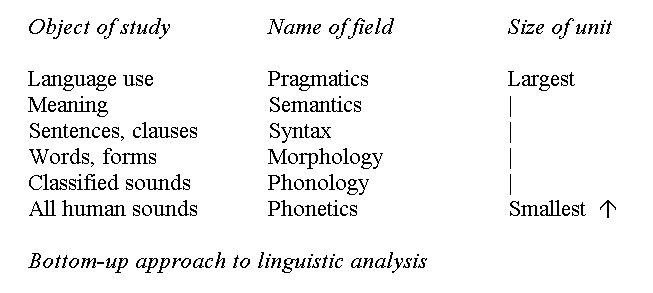





Following are levels of Linguistic Analysis:
Phonetics
Phonology
Morphology
Lexicology
Syntax
Semantics
Pragmatics
Discourse

1: Phonetics:
Phonetics is the study of production, transmission and perception of speech sound. It is concerned with the sounds of languages, how these sounds are articulated and how the hearer perceives them. Phonetics is related to science of acoustics in that it uses much the same techniques in the analysis of sounds that acoustics does. There are three branches of Phonetics:
i- Articulatory Phonetics:
It is the study of production of speech sounds.
ii- Acoustic Phonetics:
It is the study of physical production and transmission of speech sounds.
iii- Auditory Phonetics:
It is the study of perception of speech sounds.
2: Phonology:
It is the study of the patterns of language. It is concerned with how sounds are organized in a language. It examines what occurs to speech sounds when they are combined to form a word and how these speech sounds interact with each other. It endeavors to explain what these phonological processes are in terms of formal rules.
The 'phonemes' of a particular language are those minimal distinct units of sound that can distinguish meaning in that language. For example, in English the /p/ sound is phoneme because it is the smallest unit of sounds of bill,till or drill, making the word pill. The vowel sound of pill is also a phoneme because its distinctness in sound makes pill, which means one thing sounds different from pal, which has different meaning.
3: Morphology:
It is the study of word formation and structure. It studies how words are put together from their smaller parts and the rules governing this process. The elements that are combining to form words are called Morpheme. A morpheme is the smallest unit of syntax you can have in language. The cats, for example, contains the morphemes cat and the plurals.
4: Lexicology:
It is the study of words.We study word-formation and world classes.Lexeme is the smallest unit of Lexis.
5: Syntax:
It is the study of sentence structure.It attempts to described what are grammatical rules in particular language. These rules detail an underlying structure and a transformational process.The underlying structure of English e.g would have a subject -verb - object sentence order. For example: John hit the ball
The transformational process would allow a change of word order, which could give us something like, the ball was hit by John.
6: Semantics:
It is the study of meaning in language.It is concerned with describing how we represent the meaning of word in our mind how we use this representation in constructing sentence.It is based largely on the study logic in philosophy.
7: Pragmatics:
It studies the factors that govern our choice of language in social interaction and the affects of our choices on others. In theory, we can say any thing we like. In practice we follow a large number of social rules (some of them unconsciously) that constrain the way we like to speak
For example, there is now law that says we must not tell jokes during a funeral, but it is generally not done.
8: Discourse:
It is the study of stretches of spoken and written language above the sentence.
or
The way sentences work in sequence to produce coherent stretches of language.

Website design / content / graphics by Fakhar Alam © 2015 Prof. Fakhar Alam